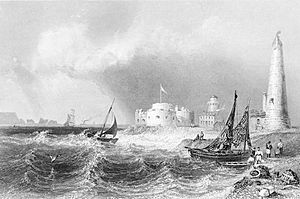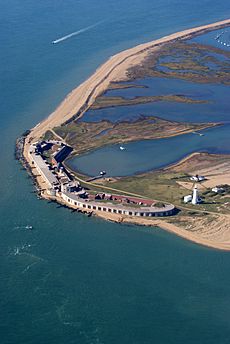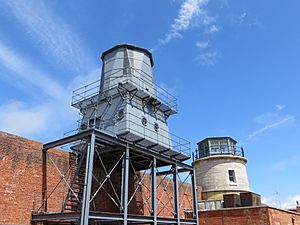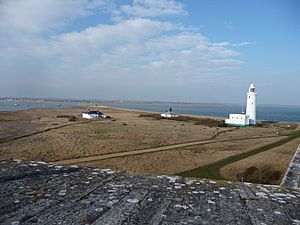Hurst Point Lighthouse facts for kids
 |
|
| Hurst Point Lighthouse | |
|
|
|
| Location | Hurst Spit Hampshire England |
|---|---|
| Coordinates | 50°42′28.7″N 1°33′1″W / 50.707972°N 1.55028°W |
| Year first constructed | 1812 (first) |
| Year first lit | 1867 (current) |
| Automated | 1923 |
| Construction | masonry tower |
| Tower shape | cylindrical tower with balcony and lantern |
| Markings / pattern | white tower and lantern |
| Height | 26 m (85 ft) |
| Focal height | 23 m (75 ft) |
| Current lens | 1st order 920mm fixed lens |
| Intensity | white: 7,140 candela red: 1,760 candela |
| Range | white: 13 nmi (24 km) red: 10 nmi (19 km) |
| Characteristic | Fl (4) WR 15s. F WRG at 19 metres (62 ft) |
| Admiralty number | A0538.1 |
| NGA number | 0596 |
| ARLHS number | ENG 057 |
The Hurst Point Lighthouse stands tall at Hurst Spit in Hampshire, England. Its job is to help ships find their way safely. It guides them through the western entrance to The Solent, which is a busy waterway.
Contents
History of Hurst Point Lighthouse
The First Lighthouses
The very first lighthouse here was called the Hurst Tower. It was built near the old Hurst Castle and first lit on September 29, 1786. Richard Jupp was the architect. Joseph Huddart helped build it. Two other lighthouses were built at the same time. One was on St. Catherine's Down and another near The Needles. These three lights were meant to work together.
The Hurst Tower was made of red brick. It showed a steady white light. Part of its light was blocked. This was to stop it from confusing ships further along the coast.
People soon realized that the Hurst Tower light was sometimes hidden. It was blocked by the Needles from certain directions. So, in 1812, a new lighthouse was added. This was the High Lighthouse. It was taller and designed by Daniel Alexander. This new tower was also made of red brick. It had a unique, cone-like shape.
These two lighthouses worked as "leading lights." This means they helped ships line up correctly. They guided vessels through the Needles Channel. Both towers used special lamps and reflectors. The Low Lighthouse had a light shining from a lower window. It also had another lamp pointing the opposite way. This second lamp guided ships in The Solent. Each lighthouse had a home for its keeper.
New Lighthouses Are Built
Between 1865 and 1873, Hurst Castle got much bigger. Because of this, the two old lighthouses had to be replaced. In 1865, a new Low Light was built. It was a white, round granite tower with a red top. This new light was attached to the castle's new wall.
Then, in 1867, a new High Light was built. James Douglass designed it. This tower was 26 meters (85 feet) tall. It was placed 15 meters (49 feet) east of the old High Light. This kept it in the right spot for guiding ships. Only the very top of the new Low Light could be seen. So, a red screen was put outside the castle walls. This made the tower look complete from a distance. The lights they showed were similar to the old ones. However, the light guiding ships up the Solent now came from the High Lighthouse.
In the 1890s, the High Light got new, powerful lenses. These were called first-order Fresnel lenses. They helped make the light much brighter and more focused. A special lamp with six wicks was also added. These lenses helped guide ships in different directions. One part of the lens helped guide ships through the Needles Channel. Another part guided ships coming from The Solent. A red light also warned ships about a dangerous area called Solent Banks.
A special system was also installed. It made the light briefly disappear for two seconds every ten seconds. This was called an "occulting mechanism." But the light stayed steady when it was guiding ships with the Low Light.
By 1911, the sandbanks had moved. This meant the Low Light was no longer in the right place. So, it was replaced again. The new Low Light was a red, square metal tower. It was built on steel beams next to the castle wall. This design allowed it to be moved if the sandbanks shifted again. It also had a first-order lens.
In 1923, both lighthouses became automatic. This meant keepers no longer had to be there all the time. They installed acetylene lamps. These lamps were controlled by a "sun valve." This valve turned the light on when it got dark and off when the sun came up. The gas was made nearby using rainwater and calcium carbide. This gas plant was removed in 1968. After that, bottled gas was used.
In 1997, the lighthouse got electric power. Because more ships were using the lanes, a very bright "sector light" was added. This light could be seen day and night. It was placed in one of the lower windows of the High Lighthouse. This light uses white, red, and green beams. It helps ships navigate the narrow passage between the Needles and the Shingles Bank very precisely. Because of this new light, the Low Light was no longer needed. It was turned off that same year.
Hurst Point Lighthouse Today
The High Lighthouse, now simply called Hurst Point Lighthouse, is still working today. It switched from gas to electric power in 1997. It still uses its original powerful lenses and red warning light.
You can visit the lighthouse, but you can't drive there. You have to walk or take a boat. The old equipment that made the acetylene gas is still there. You can also see the old gas burner at the bottom of the tower. There's a small museum about lighthouses inside the castle. It's run by the Association of Lighthouse Keepers.
Both the 1865 and 1911 Low Lights are still in place. They are painted grey so they don't confuse sailors. The 1911 Low Light still has its old lamp and lens inside.
See also
 In Spanish: Faro de Punta de Hurst para niños
In Spanish: Faro de Punta de Hurst para niños






